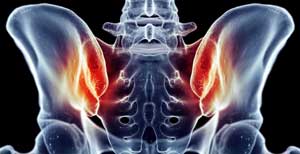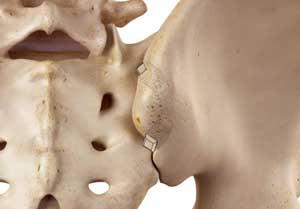Minimally Invasive procedure for SI Joint Pain
Written by Nevada Advanced Pain Specialists staff

About SACROILIAC (SI) JOINT Instability
The sacroiliac joints (SI) are the foundation of the spine, located at the junctions of the sacrum and ilium on each side.
These complex joints, composed of systems of ligaments and multiplanar joint surfaces, transmit the forces exerted through the spine from the upper body to the legs. The SI joint is designed to absorb some shock forces, but is only designed for minute motion. Instability in the SI Joint is a major pain generator in some patients.
Although there have been many advances in surgical techniques to address instability problems in the lumbar spine, instability in the SI joint has remained relatively unaddressed, with most patients running out of options once conservative treatments have failed to offer continued relief from painful SI symptoms.
Causes of SI Joint Instability and Pain: Prior injury or accident, Arthritis, Low back instability or prior low back surgery, Ligamentous loosening due to Pregnancy
Common Symptoms of Pain Involving the SI Joint Include: Low back pain, Pelvis/buttock pain, Lower extremity pain, Hip/groin pain, Problems sitting, sleeping, or walking
Treatment Cycle and Options
When it is suspected that some or all of a patient’s symptoms could be attributed to SI Joint instability, it is recommended to begin with conservative treatment options. Conservative treatment may include physical therapy, chiropractic manipulation, patient specific exercise programs, or bracing.
Pain management evaluation and intervention may be the next step, including pain medications or therapeutic injections that may provide some patients temporary relief, but often only work short term. Radiofrequency ablation (RFA) has also been used with some success, but similar to injections, may only provide temporary relief.
SI Joint fusion should only be considered after non-surgical interventions have failed to provide a patient with an enduring solution to their pain. Fusing the SI Joint, thereby eliminating motion in the joint, can provide enduring pain relief.
The CornerLocTM SI Joint Fusion Procedure

The CornerLocTM SI Joint Fusion System has been specifically designed to achieve optimal stabilization and fusion potential, with the least invasive approach and surgical instrumentation available. After careful preparation of the SI Joint, two CornerLocTM grafts are placed orthogonally within the SI Joint, effectively creating immediate joint stability and an ideal environment for fusion.
Lateral SI Joint Fusion vs. Posterior SI Joint Fusion (CornerLocTM)
A number of SI fusion systems are available which use a “lateral approach” (from the side) to drive bulky metal hardware through the deep bed of soft tissue on the side of your hip and across the SI joint. The lateral approach may involve the risk of neural complications and is typically much more destructive to the boney structures that make up both sides of the SI joint.
The CornerLocTM SI Joint Fusion Procedure is performed using a posterior approach, through two small incisions in the lower back utilizing the shortest and safest access to the SI Joint, resulting in lower surgical trauma, reduced blood loss, shorter surgery times, and faster recovery.
To learn more about the procedure, call our office at (775) 284-8650, or ask your provider at your next appointment at Nevada Advanced Pain Specialists.
